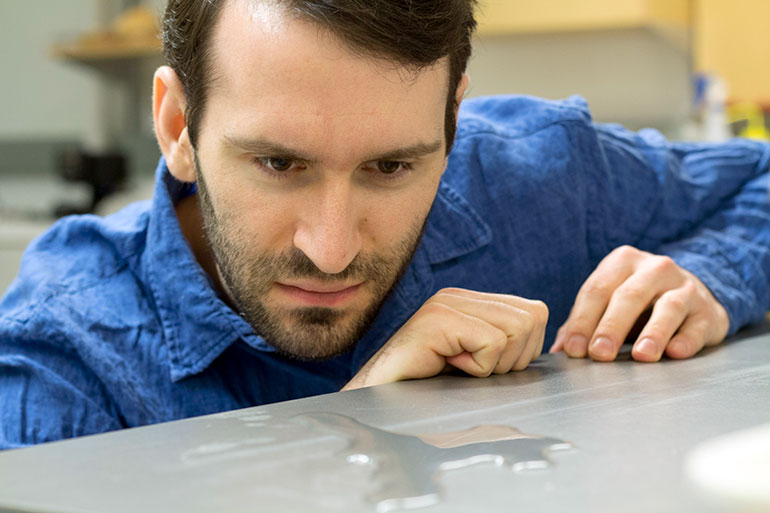
Engineering Assistant Professor Kevin Golovin observes water pooling on a superhydrophobic surface.
Superhydrophobic surfaces cut down on drag and make boats and more environmentally friendly
Boats that travel through the water, but don’t get wet. That’s the idea behind new research from UBC’s Okanagan campus that aims to make boats more efficient by creating superhydrophobic—or extremely water-repellent—surfaces.
In 2013, the Canadian marine sector emitted 5.5 megatonnes of carbon dioxide, according to Transport Canada. The vast majority of these emissions arose from burning fossil fuels to propel marine vessels.
As a result, boat manufacturers are exploring ways to limit drag by coating a ship’s hull in superhydrophobic materials.
“Superhydrophobic materials can make future marine vehicles drastically more efficient since over 60 per cent of fuel is used to overcome the friction of dragging a ship through water,” says Engineering Assistant Professor Kevin Golovin, one of the study lead authors. “In fact, we were able to create a surface that reduced that friction by over 50 per cent.”
Golovin and his team studied several different combinations of superhydrophobic surfaces in highly turbulent conditions, similar to what boats might experience when travelling through the water. The best surfaces were those that were slightly rough.
Superhydrophobic work because they contain very small holes, like divots in a golf ball. Those small pores entrap a layer of air and can significantly reduce drag, a phenomenon that Golovin says can be counterintuitive.
“Typically, it’s very smooth surfaces that have the lowest drag,” says Golovin. “Intentionally adding roughness to reduce drag is a very different approach. But the key to our study was finding the perfect balance between keeping the surface as smooth as possible while at the same time adding enough surface features to make it superhydrophobic.”
“I think we found that balance and it could be a huge benefit to future hull design.”
The study was published in the Journal of Fluid Mechanics with funding from the US Office of Naval Research.
About UBC's Okanagan campus
UBC’s Okanagan campus is an innovative hub for research and learning in the heart of British Columbia’s stunning Okanagan Valley. Ranked among the top 20 public universities in the world, UBC is home to bold thinking and discoveries that make a difference. Established in 2005, the Okanagan campus combines a globally recognized UBC education with a tight-knit and entrepreneurial community that welcomes students and faculty from around the world. For more visit ok.ubc.ca.
 Cannabis firm sues shipper
Cannabis firm sues shipper Check your travel medical
Check your travel medical New orca rescue attempt
New orca rescue attempt No bail in Ottawa killings
No bail in Ottawa killings  Banks must say rebate
Banks must say rebate  Regulating power prices
Regulating power prices Iran fires at attack drones
Iran fires at attack drones  World's largest election
World's largest election  2 detained in Volkov attack
2 detained in Volkov attack  Apple pulls apps from China
Apple pulls apps from China Oil and gas leases restricted
Oil and gas leases restricted Indigo needs turnaround
Indigo needs turnaround  Warriors ready for Round 2
Warriors ready for Round 2 Kalamalka Bowl cancelled
Kalamalka Bowl cancelled Rockets live to fight on
Rockets live to fight on Hilton teams up with Sia
Hilton teams up with Sia Swift still 'can't forgive' Kim
Swift still 'can't forgive' Kim Grimes to ‘cap the disarray’
Grimes to ‘cap the disarray’




